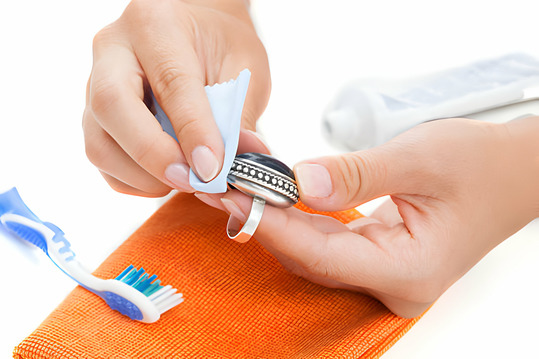
Each piece of jewelry has a story to tell about its craftsmanship and personal connection, adding to its timeless appeal. Because we adorn ourselves with these shimmering treasures, it is important to preserve their luster, and green cleaning for silver jewelry offers a gentle, environmentally friendly way to do so without using harsh chemicals. In this guide, we will explore the ins and outs of green cleaning, from natural methods to sustainable practices that bring out the best in your silver adornments. Let us dive into the art of preserving the appeal of silver jewelry while being kind to the environment.
See also our post on A Comprehensive Guide on How to Clean and Restore Antique Jewelry
What to Know About Silver and its Tarnishing Process
Composition of Sterling Silver
Recognize that most silver jewelry is made of sterling silver, an alloy containing 92.5% pure silver and 7.5% other metals, usually copper. This combination enhances the metal’s durability while retaining its intrinsic beauty.
Tarnishing Factors
Understand the factors contributing to tarnishing, such as exposure to air, moisture, and certain chemicals. Tarnish forms when silver reacts with sulfur compounds present in the environment, resulting in a dull or discolored surface.
Prevention through Storage
Minimize tarnishing by storing silver jewelry in a cool, dry place. Use airtight containers or anti-tarnish bags to create a barrier against air and humidity. Keep pieces separate to prevent scratching.
Recognizing Oxidation
Recognize that oxidation is a natural process for silver. While tarnish is undesirable, oxidation contributes to the development of a patina, a protective layer that adds character to the jewelry over time.
Occasional Professional Cleaning
Consider occasional professional cleaning for intricate or heavily tarnished pieces. Professional jewelers have the expertise to address specific cleaning needs without causing damage to the jewelry.
Gentle Cleaning Solutions from Your Kitchen
Baking Soda Paste
Create a gentle cleaning paste using baking soda and water. Apply the paste to tarnished areas, gently rub with a soft cloth or toothbrush, and rinse thoroughly. Baking soda’s mild abrasiveness helps remove tarnish without scratching.
Lemon Juice Soak
Utilize the natural acidity of lemon juice to tackle tarnish. Soak silver jewelry in a mixture of lemon juice and water for about 10-15 minutes. Gently scrub with a soft brush, rinse, and pat dry.
Salt and Aluminum Foil Bath
Immerse silver pieces in a bath of warm water, salt, and a piece of aluminum foil. The aluminum acts as a catalyst, helping remove tarnish. After a brief soak, rinse and dry your jewelry.
White Vinegar Dip
Submerge tarnished silver in white vinegar for 2-3 hours. Rinse thoroughly and pat dry. White vinegar’s acidity aids in tarnish removal while being a mild option for green cleaning.
Olive Oil and Lemon Juice Polish
Combine olive oil and lemon juice to create a natural polish. Apply the mixture to the silver, buff gently with a soft cloth, and wipe away any residue. This method not only cleans but imparts a natural shine.
See also our post on How to Revive Old and Tarnished Jewelry: Cleaning Techniques
Tips for Avoiding Harsh Commercial Cleaners
Chemical-Based Cleaners
Avoid commercial silver cleaners containing harsh chemicals like ammonia or abrasive compounds. These can strip away the protective layers and cause long-term damage to the jewelry.
Harmful Effects on Gemstones
Recognize that chemical-based cleaners can adversely affect gemstones often incorporated into silver jewelry. These cleaners may cause discoloration, degradation, or loss of shine in gems.
Potential Skin Irritation
Be cautious of cleaners that leave residues on the jewelry, as these can come into contact with the skin and lead to irritation or allergic reactions. Green cleaning methods reduce the risk of skin-related issues.
Environmental Impact
Consider the environmental impact of chemical-based cleaners. Many commercial products contain pollutants harmful to aquatic life and ecosystems. Opting for green cleaning aligns with sustainable and eco-friendly practices.
Long-Term Jewelry Integrity
Choose green cleaning methods to preserve the long-term integrity of your silver jewelry. Harsh chemicals can weaken the metal over time, leading to structural damage or compromising the jewelry’s original design.
Polishing Techniques for Lasting Brilliance
Microfiber Cloth Buffing
Use a microfiber cloth for regular buffing. This gentle material helps remove fingerprints, oils, and light tarnish, maintaining the jewelry’s natural shine without causing scratches.
Soft Toothbrush Detailing
Employ a soft toothbrush for intricate detailing. Gently scrub hard-to-reach areas to remove dirt and tarnish. Ensure the toothbrush is soft to avoid scratching the silver or any embedded gemstones.
Natural Polishing Cloth
Invest in a natural polishing cloth specifically designed for silver jewelry. These cloths are treated with non-abrasive cleaning agents that efficiently remove tarnish and restore shine.
Soft Cotton Gloves Handling
Wear soft cotton gloves when handling silver jewelry to prevent the transfer of oils and fingerprints. This simple measure contributes to the jewelry’s longevity and reduces the frequency of cleaning.
Periodic Professional Polishing
Consider periodic professional polishing for high-value or heirloom pieces. Jewelers possess the expertise to polish silver without compromising intricate details or causing damage to gemstones.
Storing Silver Jewelry with Care
Airtight Containers
Store silver jewelry in airtight containers or anti-tarnish bags. These create a protective barrier against air and humidity, minimizing tarnish and preserving the jewelry’s luster.
Silica Gel Packets
Include silica gel packets in storage containers. Silica gel helps absorb moisture, reducing the risk of tarnish. Replace the packets periodically to maintain their effectiveness.
Avoid Wood or Rubber
Avoid storing silver on wooden surfaces or in rubber containers, as these materials can release acids that accelerate tarnishing. Choose materials like felt or velvet for a gentle storage environment.
Separate Pieces to Prevent Scratching
Store individual pieces separately to prevent scratching. This precaution is particularly important for jewelry with intricate designs or multiple gemstones.
Frequent Wear and Rotation
Frequently wear your silver jewelry, as body oils can help prevent tarnishing. Rotate pieces to ensure even exposure to air and prevent long-term storage in one position.
Natural Silver Patina Appreciation
Embracing Natural Patina
Appreciate the beauty of a natural silver patina. While tarnish is generally undesirable, a gentle patina can enhance the character of certain pieces, adding a vintage or antique charm.
Polishing Selectively
Choose to polish selectively, focusing on maintaining shine while preserving areas with a patina. This approach allows you to strike a balance between cleanliness and the unique character of your silver jewelry.
Professional Assessment for Antiques
Seek professional assessment for antique silver jewelry with significant patina. Experts can provide guidance on preservation methods that honor the piece’s historical and artistic value.
Displaying Antique Pieces
Consider displaying antique pieces as art objects. A shadow box or display case can protect these cherished items while allowing you to enjoy their beauty without constant handling.
Mindful Handling of Patinated Pieces
Exercise mindfulness when handling patinated pieces. The patina is delicate, and excessive polishing may remove it. Gentle cleaning and occasional professional assessment ensure the longevity of these unique items.
Eco-Friendly Choices in Jewelry Purchases
Choosing Sustainable Brands
Support sustainable and eco-friendly jewelry brands. Look for companies that prioritize ethical sourcing of materials, environmentally conscious production methods, and transparent supply chains.
Recycled Silver Jewelry
Opt for jewelry made from recycled silver. Recycled metals contribute to reducing the environmental impact of mining and promote the reuse of existing materials.
Minimalist and Timeless Designs
Choose minimalist and timeless designs that withstand changing trends. Investing in pieces that stand the test of time reduces the frequency of purchasing new jewelry and promotes sustainability.
DIY Upcycling Projects
Explore DIY upcycling projects to breathe new life into old or unworn silver jewelry. Repurposing pieces aligns with eco-friendly practices and allows you to infuse your creativity into your collection.
Avoiding Overconsumption
Be mindful of overconsumption in the jewelry industry. Making thoughtful and intentional purchases contributes to a more sustainable and environmentally friendly approach to fashion.
See also our post on The Ultimate Guide to Cleaning and Organizing Your Jewelry Collection
Conclusion
As we conclude our exploration into the world of green cleaning for silver jewelry, we find ourselves standing at the intersection of beauty and environmental responsibility. The simplicity of natural methods not only restores the shine to our cherished pieces but also echoes a commitment to a cleaner, greener planet. Through these eco-friendly practices, we rediscover that the brilliance of silver extends beyond its aesthetic appeal—it becomes a reflection of our conscious choices and a testament to the enduring beauty of sustainable living. May the sparkle of your silver jewelry continue to shine bright, not just as a symbol of adornment but as a beacon of green elegance in a world that appreciates the simplicity of shining without harsh chemicals.




